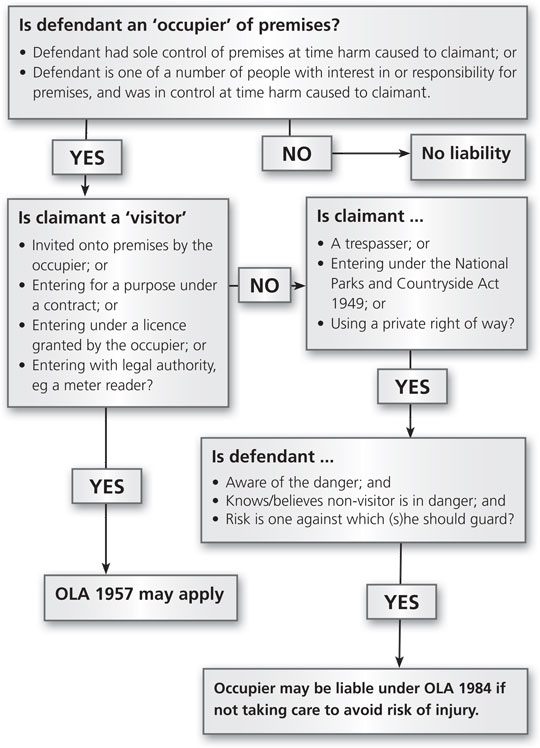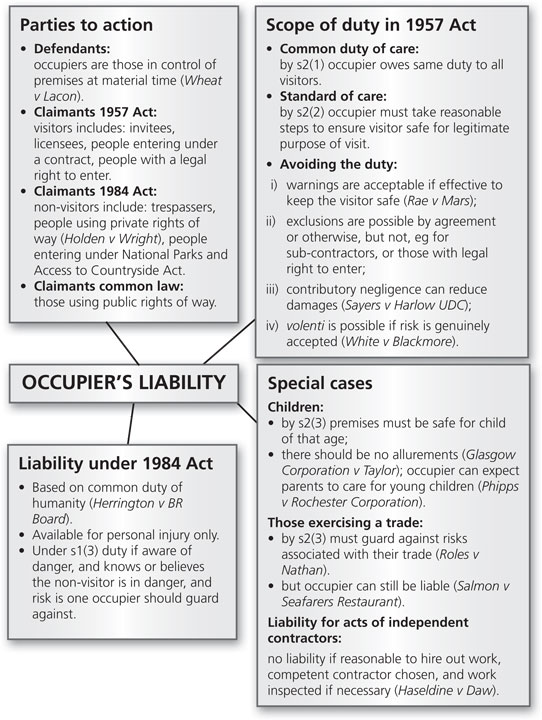Occupier’s liability

Occupier’s Liability

3.1 Liability to Lawful Visitors under the 1957 Act
3.1.1 Introduction
1. Occupier’s Liability Act 1957 – covers liability to visitors.
2. 1984 Act covers liability to non-visitors (mainly trespassers).
3. Both Acts only cover damage resulting from state of premises – other damage is covered by negligence (Ogwo v Taylor (1987)).
3.1.2 Definition of Occupier (Potential Defendants)
1. There is no real statutory definition so common law test applies: who has control of premises? (Wheat v Lacon (1966)).
2. Dual occupation possible – identity of the defendant depends on the nature of the interest, etc. (Collier v Anglian Water Authority (1983)).
3. In an action a lawyer’s main concern is who has means to be sued.
4. There is no need for proprietary interest or possession, only control, so different to trespass (Harris v Birkenhead Corporation (1976)).
3.1.3 Definition of Premises
1. No complete definition in either Act, so common law applies.
2. It obviously includes houses, buildings, land, etc. but also:
 ships in dry dock (London Graving Dock v Horton (1951));
ships in dry dock (London Graving Dock v Horton (1951));
 vehicles (Hartwell v Grayson (1947));
vehicles (Hartwell v Grayson (1947));
 lifts (Haseldine v Daw & Son Ltd (1941));
lifts (Haseldine v Daw & Son Ltd (1941));
 aircraft (Fosbroke-Hobbes v Airwork Ltd (1937));
aircraft (Fosbroke-Hobbes v Airwork Ltd (1937));
 and even a ladder (Wheeler v Copas (1981)).
and even a ladder (Wheeler v Copas (1981)).
3. The 1957 Act in s1(3)(a) preserves the common law (‘fixed or movable structure, including any vessel, vehicle or aircraft …’).
3.1.4 Potential Claimants
1. The 1957 Act simplified complex common law classes of entrant. These were:
 invitee – enters in material interest of occupier, e.g. a shop customer, a friend visiting;
invitee – enters in material interest of occupier, e.g. a shop customer, a friend visiting;
 licensee – mere permission, e.g. a person taking a short cut;
licensee – mere permission, e.g. a person taking a short cut;
 a person entering under a contract, e.g. a painter (duty depended on contract) – a subcontractor is only a licensee;
a person entering under a contract, e.g. a painter (duty depended on contract) – a subcontractor is only a licensee;
 a person entering by legal right, e.g. meter readers, police executing warrants, but also private and public rights of way;
a person entering by legal right, e.g. meter readers, police executing warrants, but also private and public rights of way;
 trespassers – no permission and no rights.
trespassers – no permission and no rights.
2. The different classes were owed different duties so s1(2) 1957 Act was replaced with ‘common duty of care’ to ‘visitors’, including:
 licensees and invitees – implied licensees must show licence created by occupier’s conduct (Lowery v Walker (1911));
licensees and invitees – implied licensees must show licence created by occupier’s conduct (Lowery v Walker (1911));
 those entering under a contract – where the contract provides for greater protection it will be owed;
those entering under a contract – where the contract provides for greater protection it will be owed;
 those entering by legal right.
those entering by legal right.
3. Visitor does not include:
 private rights of way (Holden v Wright (1982));
private rights of way (Holden v Wright (1982));
 those entering under an access agreement under the National Parks & Access to Countryside Act;
those entering under an access agreement under the National Parks & Access to Countryside Act;
 trespassers (all covered by Occupiers Liability Act 1984);
trespassers (all covered by Occupiers Liability Act 1984);
 public rights of way, covered by the common law (McGeown v Northern Ireland Housing Executive (1994)).
public rights of way, covered by the common law (McGeown v Northern Ireland Housing Executive (1994)).
3.1.5 The Scope of the Act (The Common Duty of Care)
1. By s2(1), ‘An Occupier of premises owes the same duty, the common duty of care to all his visitors except insofar as he is free to do and does extend, restrict, modify or exclude his duty.’
2. By s2(2) duty is to ‘take such care as in all circumstances … is reasonable to see that the visitor will be reasonably safe in using the premises for the purpose for which he is invited …’. Higher duty may be owed by a professional occupier (Ward v Tesco Stores Ltd (1976)) than by an ordinary homeowner (Fryer v Pearson (2000)).
3.